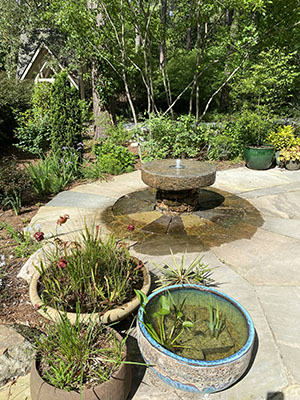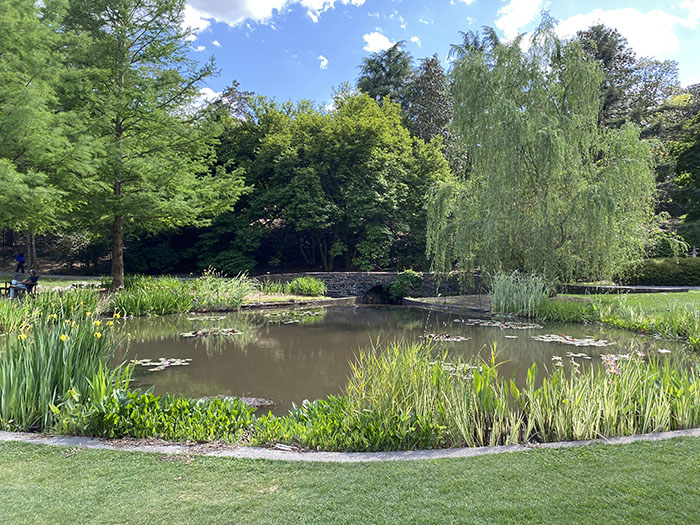Garden Talk
Try This, Not That: Aquatic Plants and Water Features
By April Stradley
Historic Gardens Horticulturist

Don’t you love when an online influencer tells you how to get in shape and lose 20 pounds in five days with one easy trick? I would guess not. You probably scroll right past those social media ads without even pausing, because you know what you’re seeing is a fiction. However, when it comes to celebrity gardening advice, we don’t seem to treat it with the same grain of salt. When influencers like Martha Stewart air a TV episode on how to build a backyard labyrinth through which one may ride one’s horse on a sunny day, we’re glued to the screen. At least, I certainly was. When Oprah interviews Adele in her Montecito rose garden, we might think, “Why don’t I have a garden like that?”
Where is your collection of tropical citrus trees? How diverse is your home native prairie? What kind of marble did you use for your backyard grotto?
I think a better question to ask ourselves is: who is this “advice” for? Because it wouldn’t apply to anyone I know. That’s not to say I don’t find it entertaining, because I do. It’s just that I hate to think of gardeners comparing their home landscapes to Oprah’s and being left feeling hopeless. In real life, gardening can be fun even when it is challenging; easy to love even through failed experiments; and most of all, it should be a source of joy. Can we allow ourselves to be fully human, as well as enthusiastic gardeners?
Maybe you’re thinking, “Duke Gardens is just as bad!” Here’s a professional’s hot take: I agree. My team planted more than 43,000 spring-flowering bulbs last fall, and we do it every year. It’s beautiful, sure. But it’s not something you would consider doing at your place.
For example, let’s consider water features. Some landscape designers insist that no garden is complete without one. A quick internet search provides 135 million videos and articles for DIY water features. Meanwhile, ecologists remind us how important it can be for homeowners to provide water for neighborhood birds and insects. The message is clear: you don’t just want a water feature, you need one.
Here at Duke Gardens, we have more than 20 water features across our 55-acre campus. They are often the most popular attractions on our grounds, no matter what is in bloom, and for good reasons. They’re beautiful, soothing, cooling, and home to some interesting bugs and critters. We have something like seven ponds, six waterfalls, five fountains, and various other pools and streams. Each one also needs regular servicing, maintenance, cleaning, water testing, and chemical balancing. Some of that work is done by volunteers, some by contracted professionals, and some by determined horticulturists, learning as they go.
The upkeep alone for our water features uses up an incredible amount of time, energy, human labor and money. We spend upward of $2000 per year on aquatic plants for our fountains, ponds and pools, not including the cost of human labor to install and maintain the plants. Even the smallest of the fountains in the Historic Gardens must be cleaned twice a year, topped off daily in the summers, cleared of trash and debris daily, and serviced annually by a professional contractor. Easy, quick and cheap, right? Just like the internet promises.
Don’t despair. There are actually plenty of beautiful and easily achievable options for water features and aquatic plants that you can DIY at home, like containerized aquatic arrangements, recirculating fountains, and ephemeral creeks to manage storm water. You don’t just want these water features, you need them. But don’t just take my word as a budding internet influencer—research, explore and decide for yourself.
Learn more: April Stradley will teach “Try This, Not That: Aquatic Plants and Water Features,” on site at Duke Gardens on Tuesday, May 23, from 2:30 to 4 p.m. The program is for gardeners or aspiring gardeners at all levels. Read more about this class and others in the "Try This, Not That" series on our program registration site.
Photos from top: Aquatic plants line the edges of the South Lawn pond; a fountain made of millstones and basins of carnivorous plants in the Blomquist Garden of Native Plants' redesigned wildlife garden; the Millstone Pond in the Blomquist Garden provides a wonderful habitat for aquatic plants and wildlife. Photos by April Stradley.







